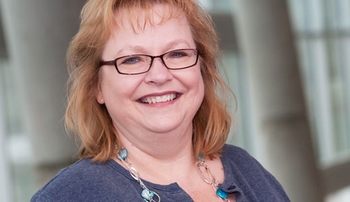Shawn Smith remembers her first chemo session. Smith had been diagnosed with breast cancer in the spring of 2009. She’d felt the tension of the diagnostic medical sonographer saying the doctor needed to see the ultrasound, and alarm when he said: That does not look good.
After that, she underwent surgery.
 |
Shawn Smith |
“Reality was setting in,” Smith said.
Light in the darkness
But it was also in that dark moment that Smith first realized the competence and kindness exhibited at UNMC and its hospital partner, The Nebraska Medical Center.
And she started to fathom how much of it came from those in allied health professions.
The rest of the team
Patients in treatment for breast cancer see doctors, of course.
But physician assistants also see patients. Radiographers perform mammograms.
Cytotechnologists perform microscopic examinations of slides to help make an interpretation of the disease. Clinical laboratory scientists perform sophisticated tests and monitor patients during treatment.
Radiation therapists administer treatment and assess it daily. Diagnostic medical sonographers assist in ultrasound-guided biopsies. Nuclear medicine and molecular Imaging technologists administer treatment and track patients with diagnostic imaging.
Nutrition therapists discuss how to stay strong. Physical therapists help patients bounce back.
The full scope
“It’s mind-boggling,” Smith said.
But more so was how, at each step, each of these allied health professionals made her feel like a person, not a cancer patient.
In treatment, Smith had a lot of time to watch the way things worked. Her treatment, Smith realized, was interdepartmental, and virtually seamless.
Everyone seemed to already know everything about her; they were all on the same page.
All the pieces fit
Each of them was an interlocking puzzle piece.
“People say you can’t teach good bedside manners,” Smith said. “That it has to be inherent. But I think they’re wrong.
“It’s being taught here.”
On the other side
Smith was diagnosed April 6, 2009. Her official “You look good” was Jan. 5, 2012. She is grateful to her doctors and nurses. But she’s also grateful to all the others who were right there with her, who were working for her. She’s grateful to the professionals of allied health.
Awesome article! This really shows the teamwork involved in health care and the importance of each professional involved, from diagnostics through treatment and recovery. Thanks to Shawn for sharing her story!